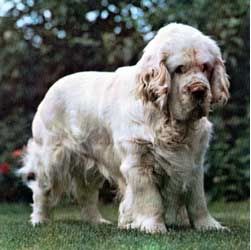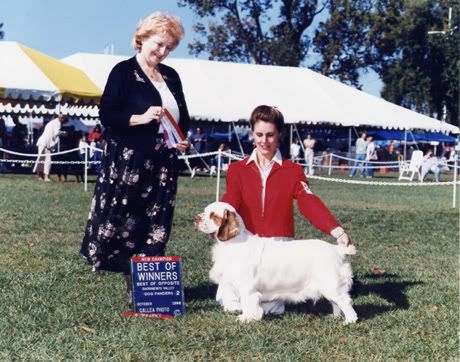Post by DogGoneGood on Dec 30, 2008 14:53:00 GMT -5
Group: 1 - Sporting
Origin: Great Britain, 1750
Purpose: Excellent at trailing, flushing, and retrieving game, the Clumber has a white coat which enables him to be seen by the hunter as he works within gun range. He is a silent worker with an excellent nose.

Breed Standard
General Appearance: A long, low, heavy-looking dog. His heavy brow, deep chest, straight forelegs, powerful hindquarters, massive bone, and substantial feet all give him the power and endurance to move through dense underbrush in persuit of game. His stature is dignified, his expression thoughtful, but at the same time he shows great enthusiasm for his work and play. More emphasis should be given to his overall appearance, balance, and movement than to any individual parts.
Coat and Colour: He has a medium-length coat that is straight, silky and dense with well feathered legs and chest. He is predominantly white with lemon or orange markings. He may have markings around one eye, both eyes or a completely white face and freckles on the muzzle, forelegs and ears are also common.
Head: Large and massive in all dimensions; round above the eyes, flat on top, with a furrow running between the eyes and up through the center of the skull. There is a marked stop and large occipital protuberance.
Neck: Long, thick, and powerful with a large ruff. Some slackness of throat on pressence of dewlap not to be faulted.
Forequarters: Shoulders immensely strong and muscular, giving a heavy appearance, to the front. Forelegs short, straight, and very heavy in bone, elbows close to the body. Feet are large, round, compact, with thick pads, well-matched to the bone of the forequarters.
Hindquarters: Only slightly less heavily boned than the forelegs. They are moderately angulated, and the hock to the heel is short and perpendicular to the ground. Quarters well-developed and muscular. Rear feet are slightly smaller than the front feet with substantial pads.
Body: Long, low and well ribbed up. The chest is wide and deep, the back is long, broad, and level, with very slight arch over the loin.
Tail: Set on just below the line of the back, well feathered, carried parallel to the back or slightly elevated. A docked and an undocked tail are of equal value.
Gait: Because of his wide body and short legs, he tends to roll slightly. The proper Clumber roll occurs when the correctly-proportioned dog reaches forward with rear legs toward the center line of gravity and rotates the hip downward while the back remains level and straight. This gait is comfortable and can be maintained at a steady trot for a day of work in the field without exhaustion.
Faults: Excessive shyness, viciousness.
Size:
Height:
Males — 18 to 20 inches at the withers
Females — 17 to 19 inches at the withers
Weight:
Males — 70 to 85 lbs (31-38.6 kg)
Females — 55 to 70 lbs (25-31 kg)

Temperament:
The Clumber is a loyal and affectionate dog. His thoughtful and kind expression give him an appearance of dignity but he is also enthusiastic about work and play. He can be reserved but never hostile or timid. The Clumber is a strong, muscular and powerful dog who may appear heavy and slow; however, he is neither slow in movement or thought. Overall, the Clumber is a faithful companion, kind, loving, always eager to please, loves children and generally gets along well with other dogs.
History: The Clumber Spaniel is thought to have come from a blending of the Basset Hound with an early European spaniel, the now extinct Alpine Spaniel. The name comes from Clumber Park in Nottinghamshire. Although not the fastest of the Spaniels, the Clumber is a sturdy dog with excellent trailing, flushing and retrieving abilities, and was valued for his ability to work in dense undergrowth and as a game finder.
Sources:
CKC Breed Standard: Group 1 - Sporting: 1-24
Canada's Guide to Dogs - CLUMBER SPANIEL — BREED DESCRIPTION & INFORMATION
Origin: Great Britain, 1750
Purpose: Excellent at trailing, flushing, and retrieving game, the Clumber has a white coat which enables him to be seen by the hunter as he works within gun range. He is a silent worker with an excellent nose.

Breed Standard
General Appearance: A long, low, heavy-looking dog. His heavy brow, deep chest, straight forelegs, powerful hindquarters, massive bone, and substantial feet all give him the power and endurance to move through dense underbrush in persuit of game. His stature is dignified, his expression thoughtful, but at the same time he shows great enthusiasm for his work and play. More emphasis should be given to his overall appearance, balance, and movement than to any individual parts.
Coat and Colour: He has a medium-length coat that is straight, silky and dense with well feathered legs and chest. He is predominantly white with lemon or orange markings. He may have markings around one eye, both eyes or a completely white face and freckles on the muzzle, forelegs and ears are also common.
Head: Large and massive in all dimensions; round above the eyes, flat on top, with a furrow running between the eyes and up through the center of the skull. There is a marked stop and large occipital protuberance.
Neck: Long, thick, and powerful with a large ruff. Some slackness of throat on pressence of dewlap not to be faulted.
Forequarters: Shoulders immensely strong and muscular, giving a heavy appearance, to the front. Forelegs short, straight, and very heavy in bone, elbows close to the body. Feet are large, round, compact, with thick pads, well-matched to the bone of the forequarters.
Hindquarters: Only slightly less heavily boned than the forelegs. They are moderately angulated, and the hock to the heel is short and perpendicular to the ground. Quarters well-developed and muscular. Rear feet are slightly smaller than the front feet with substantial pads.
Body: Long, low and well ribbed up. The chest is wide and deep, the back is long, broad, and level, with very slight arch over the loin.
Tail: Set on just below the line of the back, well feathered, carried parallel to the back or slightly elevated. A docked and an undocked tail are of equal value.
Gait: Because of his wide body and short legs, he tends to roll slightly. The proper Clumber roll occurs when the correctly-proportioned dog reaches forward with rear legs toward the center line of gravity and rotates the hip downward while the back remains level and straight. This gait is comfortable and can be maintained at a steady trot for a day of work in the field without exhaustion.
Faults: Excessive shyness, viciousness.
Size:
Height:
Males — 18 to 20 inches at the withers
Females — 17 to 19 inches at the withers
Weight:
Males — 70 to 85 lbs (31-38.6 kg)
Females — 55 to 70 lbs (25-31 kg)

Temperament:
The Clumber is a loyal and affectionate dog. His thoughtful and kind expression give him an appearance of dignity but he is also enthusiastic about work and play. He can be reserved but never hostile or timid. The Clumber is a strong, muscular and powerful dog who may appear heavy and slow; however, he is neither slow in movement or thought. Overall, the Clumber is a faithful companion, kind, loving, always eager to please, loves children and generally gets along well with other dogs.
History: The Clumber Spaniel is thought to have come from a blending of the Basset Hound with an early European spaniel, the now extinct Alpine Spaniel. The name comes from Clumber Park in Nottinghamshire. Although not the fastest of the Spaniels, the Clumber is a sturdy dog with excellent trailing, flushing and retrieving abilities, and was valued for his ability to work in dense undergrowth and as a game finder.
Sources:
CKC Breed Standard: Group 1 - Sporting: 1-24
Canada's Guide to Dogs - CLUMBER SPANIEL — BREED DESCRIPTION & INFORMATION

